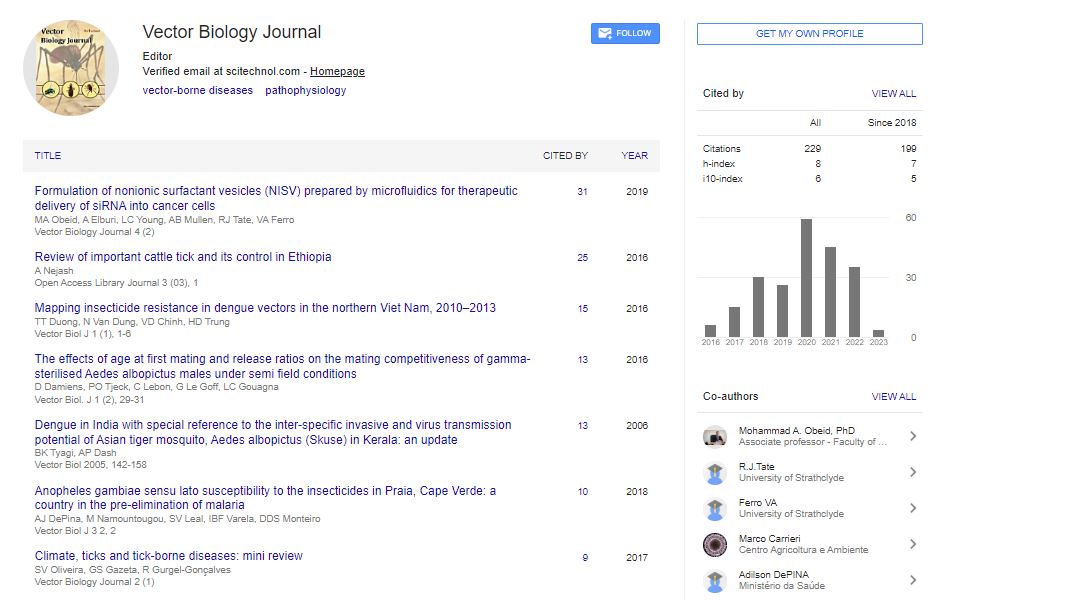Short Communication, Vector Biol J Vol: 8 Issue: 4
Epidemiology, Clinical Manifestations, Diagnosis, Treatment, of Sleeping Sickness
Zebaze Arnol*
1Department of Biochemistry, University of Dschang, Dschang, Cameroon
*Corresponding Author: Zebaze Arnol,
Department of Biochemistry, University of
Dschang, Dschang, Cameroon
E-mail: arnol.ze@gmail.com
Received date: 21 November, 2023, Manuscript No. VBJ-24-127795;
Editor assigned date: 23 November, 2023, PreQC No. VBJ-24-127795 (PQ);
Reviewed date: 07 December, 2023, QC No. VBJ-24-127795;
Revised date: 15 December, 2023, Manuscript No. VBJ-24-127795 (R);
Published date: 22 December, 2023, DOI: 10.4172/2473-4810.1000272.
Citation: Arnol Z (2023) Epidemiology, Clinical Manifestations, Diagnosis, Treatment, of Sleeping Sickness. Vector Biol J 8:4.
Description
Sleeping sickness, also known as African trypanosomiasis, it is a neglected tropical disease that affects some of the most vulnerable populations in sub-Saharan Africa. Caused by the protozoan parasites Trypanosoma brucei gambiense and Trypanosoma brucei rhodesiense, sleeping sickness is transmitted to humans through the bite of infected tsetse flies of the genus Glossina [1-5].
The epidemiology of sleeping sickness is complex, with two different forms of the disease prevalent in different regions of sub- Saharan Africa. Trypanosoma brucei gambiense causes the chronic form of sleeping sickness, primarily affecting West and Central Africa, while Trypanosoma brucei rhodesiense causes the acute form, predominantly found in East and Southern Africa. The transmission cycle involves the cyclical development of the parasite within the tsetse fly vector and its transmission to humans during blood meals [6,7].
The clinical manifestations of sleeping sickness typically progress through two stages, each characterized by different symptoms. In the early or hemolymphatic stage, patients may experience non-specific symptoms such as fever, headaches, joint pains, and lymphadenopathy. As the disease progresses to the late or neurological stage, parasites invade the central nervous system, leading to neurological symptoms including sleep disturbances, behavioral changes, confusion, and ultimately, coma and death if left untreated [8,9].
Diagnosing sleeping sickness represents significant challenges due to the non-specific nature of early symptoms and the limited availability of diagnostic tools in endemic areas. Laboratory confirmation of the disease involves the detection of parasites in blood, lymph node aspirates, or cerebrospinal fluid using microscopy, Polymerase Chain Reaction (PCR), or serological tests. However, access to diagnostic facilities and skilled personnel remains a barrier to timely diagnosis and treatment in many endemic regions [10].
Treatment options for sleeping sickness depend on the stage of the disease and the species of Trypanosoma involved. For the chronic form caused by Trypanosoma brucei gambiense, first-line treatment involves the administration of pentamidine or suramin for early-stage cases and eflornithine or a combination of eflornithine and nifurtimox for late-stage cases. The acute form caused by Trypanosoma brucei rhodesiense is treated with suramin for early-stage cases and melarsoprol or a combination of nifurtimox and eflornithine for latestage cases.
Despite significant progress in the diagnosis and treatment of sleeping sickness, challenges remain in ensuring access to care for affected populations, particularly in remote and underserved areas. Weak healthcare systems, inadequate infrastructure, and limited resources represent difficulties to effective case detection, treatment, and surveillance. Additionally, the remote and potentially dangerous areas where sleeping sickness is endemic further complicate control efforts, hampering vector control interventions and surveillance activities.
Vector control measures are integral components of sleeping sickness control programs, aimed at reducing tsetse fly populations and interrupting disease transmission. Techniques include the use of insecticide-treated targets, traps, and screens, as well as environmental management techniques to minimize tsetse fly breeding habitats. However, sustaining vector control efforts requires long-term commitment, community participation, and interdisciplinary collaboration across sectors such as health, agriculture, and environmental conservation.
Study and innovation plays an important role in advancing the understanding of sleeping sickness and developing new tools and methods for its prevention and control. Efforts to develop new drugs, diagnostics, and vector control technologies are starting, with a focus on improving treatment efficacy, safety, and accessibility. Additionally, community engagement and capacity-building initiatives empower local communities to participate in disease surveillance, vector control, and health education efforts. By organizing investment in study, innovation, and collaborative partnerships, Individuals can work together to eliminate sleeping sickness and improve the physical and mental well-being of those who are infected.
References
- Idrees S, Ashfaq UA (2012) A brief review on dengue molecular virology, diagnosis, treatment and prevalence in Pakistan. Genet Vaccines Ther 10:10-16.
[Crossref] [Google Scholar] [PubMed]
- Amarasinghe A, Kuritsky JN, Letson GW, Margolis HS (2011) Dengue virus infection in Africa. Emerg Infect Dis 17(8):1349.
[Crossref] [Google Scholar] [PubMed]
- Shuaib W, Stanazai H, Abazid AG, Mattar AA (2016) Reemergence of Zika virus: A review on pathogenesis, clinical manifestations, diagnosis, treatment, and prevention. Am J Med 129(8):879-e7.
[Crossref] [Google Scholar] [PubMed]
- Ooi EE, Gubler DJ (2009) Dengue in Southeast Asia: Epidemiological characteristics and strategic challenges in disease prevention. Cadernos de saude publica 25:S115-24.
[Crossref] [Google Scholar] [PubMed]
- Kautner I, Robinson MJ, Kuhnle U (1997) Dengue virus infection: Epidemiology, pathogenesis, clinical presentation, diagnosis, and prevention. J Pediatr 131(4):516-524.
[Crossref] [Google Scholar] [PubMed]
- Khetarpal N, Khanna I (2016) Dengue fever: Causes, complications, and vaccine strategies. J Immunol Res.
[Crossref] [Google Scholar] [PubMed]
- Itrat A, Khan A, Javaid S, Kamal M, Khan H, et al (2008) Knowledge, awareness and practices regarding dengue fever among the adult population of dengue hit cosmopolitan. PloS one 3(7):e2620.
[Crossref] [Google Scholar] [PubMed]
- Roy SK, Bhattacharjee S (2021) Dengue virus: Epidemiology, biology, and disease aetiology. Can J Microbiol 67(10):687-702.
[Google Scholar] [PubMed]
- Muller DA, Depelsenaire AC, Young PR (2017) Clinical and laboratory diagnosis of dengue virus infection. J Infect Dis 215:S89-95.
- Sood SK, Sood V, Mahajan I (2021) An intelligent healthcare system for predicting and preventing dengue virus infection. Computing 8:1-39.
 Spanish
Spanish  Chinese
Chinese  Russian
Russian  German
German  French
French  Japanese
Japanese  Portuguese
Portuguese  Hindi
Hindi 